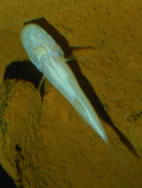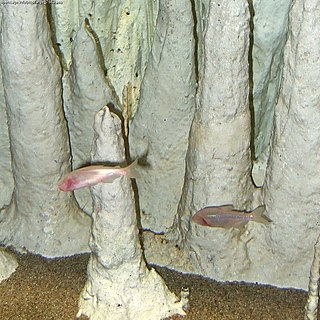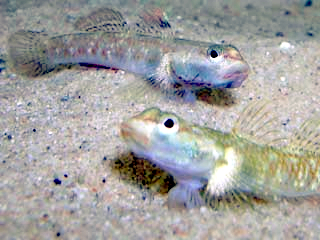
The Amblyopsidae are a fish family commonly referred to as cavefish, blindfish, or swampfish. They are small freshwater fish found in the dark environments of caves, springs and swamps in the eastern half of the United States. Like other troglobites, most amblyopsids exhibit adaptations to these dark environments, including the lack of functional eyes and the absence of pigmentation. More than 200 species of cavefishes are known, but only six of these are in the family Amblyopsidae. One of these, Forbesichthys agassizii, spends time both underground and aboveground. A seventh species in this family, Chologaster cornuta, is not a cave-dweller but lives in aboveground swamps.

Eleotridae is a family of fish commonly known as sleeper gobies, with about 34 genera and 180 species. Most species are found in the tropical Indo-Pacific region, but there are also species in subtropical and temperate regions, warmer parts of the Americas and near the Atlantic coast in Africa. While many eleotrids pass through a planktonic stage in the sea and some spend their entire lives in the sea; as adults, the majority live in freshwater streams and brackish water. One of its genera, Caecieleotris, is troglobitic. They are especially important as predators in the freshwater stream ecosystems on oceanic islands such as New Zealand and Hawaii that otherwise lack the predatory fish families typical of nearby continents, such as catfish. Anatomically, they are similar to the gobies (Gobiidae), though unlike the majority of gobies, they do not have a pelvic sucker.

The Alabama cavefish, is a critically endangered species of amblyopsid cavefish found only in underground pools in Key Cave, located in northwestern Alabama, United States in the Key Cave National Wildlife Refuge. It was discovered underneath a colony of gray bats in 1967 and scientifically described in 1974.

Astyanax jordani is a freshwater fish of the characin family of order Characiformes, native to Mexico. It is sometimes called the cave tetra, or by its local Spanish name tetra ciego.
Protocobitis is a genus of loaches endemic to Guangxi in China and living in caves.
Eleotris pellegrini is a species of fish in the family Eleotridae endemic to Madagascar where it can be found in mangrove swamps. This species can reach a length of 23 cm (9.1 in). The specific name honours the French ichthyologist Jacques Pellegrin (1873-1944), who discovered this species in 1933 but thought that it was Eleotris vittata.
Milyeringa is a genus of blind cavefish from the Cape Range and Barrow Island, northwestern Australia. Although traditionally considered to belong to the family Eleotridae, studies show that they represent a distinct and far-separated lineage together with the Typhleotris cavefish from Madagascar, leading some to move them to their own family, Milyeringidae. The generic name is taken from Milyering which is 20 miles (32 km) southwest of Vlamingh Head in the North West Cape of Western Australia, the type locality for Milyeringa veritas.

Paretroplus is a genus of fishes in the cichlid family, all of which are endemic to lakes and rivers of Madagascar. The vast majority are threatened and restricted to the northwestern part of the island. Only P. polyactis is found in the southern half of Madagascar and only P. polyactis and P. gymnopreopercularis are found in eastern drainages. Most are restricted to freshwater, but at least P. polyactis and P. maromandia can also be seen in brackish habitats.

Ratsirakia legendrei is a species of fish in the family Eleotridae endemic to fresh waters of Madagascar. This species can reach a length of 17 cm (6.7 in). It is the only known member of its genus. It is the only species in the monotypic genus Ratsirakia, the name of which honours Didier Ratsiraka who was President of Madagascar from 1975-1993 and from 1997-2002 while the specific name refers to the French physician Jean Legendre who discovered the species while serving with French colonial troops in Madagascar.
Typhleotris pauliani is a critically endangered species of fish in the family Milyeringidae that is endemic to Madagascar, where it is only known from a few caves and sinkholes in the southwestern portion of the island. This blind cavefish lacks pigmentation and can reach a standard length of 7.1 cm (2.8 in). It feeds on invertebrates and guano. Part of its range receive some protection, but the species is threatened by disturbance from recreational activities and collectors of guano. The specific name honours the French entomologist and former deputy director of the Institut de recherche pour le développement in Madagascar, Renaud Paulian (1913-2003), who collected the type specimens as well as contributing a lot to the knowledge of the biogeography of the western Indian Ocean.

The Gobiiformes are an order of fish that includes the gobies. The order, which was previously considered a suborder of Perciformes, is made up of 2,211 species that are divided into seven different families. Phylogenetic relationships of the Gobiiformes have been elucidated using molecular data. Gobiiforms are generally small fish and are mostly marine (saltwater) fishes, but roughly 10% of the population inhabit fresh waters. This order is made up of mainly benthic or sand-burrowing fish. Benthic fish live on the bottom of a body of water. Like in most benthic organisms, gobiiforms do not have a gas bladder or swim bladder which keeps them from suspending in the water column, so they must stay on the bottom.

Amblyopsis is a genus of small fish in the family Amblyopsidae that are endemic to the central and eastern United States. Like other cavefish, they lack pigmentation and are blind. The most recently described species was in 2014. Uniquely among fish, Amblyopsis brood their eggs in the gill chambers. It was formerly incorrectly speculated that the same brooding behavior existed in other genera in the family and in the pirate perch.

The Hoosier cavefish is a subterranean species of blind fish from southern Indiana in the United States. Described in 2014, A. hoosieri was the first new species of amblyopsid cavefish to be discovered in 40 years.
Caecieleotris morrisi, also known as the Oaxaca cave sleeper is a species of troglobitic fish in the family Eleotridae found in a single cave system beneath Presa Miguel Alemán reservoir, northern State of Oaxaca in Mexico. This species is the only member of its genus.

Milyeringidae, the blind cave gobies, is a small family of gobies, in the order Gobiiformes. There are two genera and six species within the family, which is considered to be a subfamily of the Eleotridae by some authorities. Milyeringidae includes one genus (Milyeringa) restricted to caves in the North West Cape region of Australia and the other (Typhleotris) to underground water systems in Madagascar. They are all troglobitic species and have lost their eyes.













